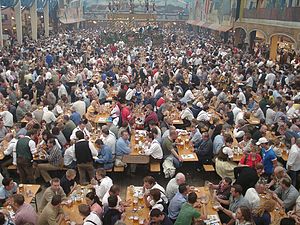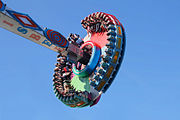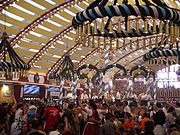Oktoberfest
From Wikipedia, the free encyclopedia
| This article needs additional citations for verification. Please help improve this article by adding reliable references (ideally, using inline citations). Unsourced material may be challenged and removed. (July 2007) |
Oktoberfest is a sixteen-day festival held each year in Munich, Germany during late September (and running to early October). It is one of the most famous events in Germany and the world's largest fair, with some six million people attending every year, and is an enjoyable event with an important part of Bavarian culture. Other cities across the world also hold Oktoberfest celebrations, modeled after the Munich event.
Oktoberfestbiers are the beers that have been served at the event in Munich since 1818, and are supplied by 6 breweries known as the Big Six: Spaten, Löwenbräu, Augustiner, Hofbräu, Paulaner and Hacker-Pschorr.[1] Traditionally Oktoberfestbiers were the lagers of around 5.5 to 6% abv called Märzen - brewed in March and allowed to ferment slowly during the summer months.[2] Originally these would have been dark lagers, but from 1872 a strong March brewed version of an amber-red Vienna lager made by Josef Sedlmayr became the favourite Oktoberfestbier.
Since the 1970s the type of beer served at the festival has been a pale lager between 5 and 6% abv, and the terms Oktoberfest and Märzen are used by non-Oktoberfest brewers in Germany and the USA to market pale lagers of this strength.[3] The color of these lagers may range from pale gold to deep amber, with the darker colours more common in the USA. Hop levels tend not to be distinctive, though some American examples may be firmly hopped. Modern beers sold as Oktoberfest and Märzen in Europe tend not to be too differentiated from other pale lagers of this strength, while older German and American influenced examples will be fairly malty in flavour and inclined to use a range of malts, especially dark malts such as Vienna or Munich.[4]
The Munich Oktoberfest, traditionally, takes place during the sixteen days up to and including the first Sunday in October. In 1994, the schedule was modified in response to German reunification so that if the first Sunday in October falls on the 1st or 2nd, then the festival will go on until October 3 (German Unity Day). Thus, the festival is now 17 days when the 1st Sunday is October 2 and 18 days when it is October 1. The festival is held on an area named the Theresienwiese (field, or meadow, of Therese), often called d’ Wiesn for short.
Visitors also eat huge amounts of food, most of it traditional hearty fare such as Hendl (chicken), Schweinsbraten (roast pork), Haxn (knuckle of pork), Steckerlfisch (grilled fish on a stick), Würstel (sausages) along with Brezel (Pretzel)), Knödeln (potato or bread dumplings), Käsespätzle (cheese noodles), Reiberdatschi (potato pancakes), Sauerkraut or Blaukraut (red cabbage) along with such Bavarian delicacies as Obatzda (a fatty, spiced cheese-butter concoction) and Weisswurst (a white sausage).

Contents |
[edit] History
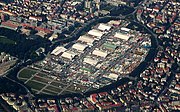
The original "Oktoberfest" occurred in Munich, on October 18, 1810: For the commemoration of their marriage, Crown Prince Ludwig (later King Ludwig I) and Princess Therese of Saxe-Hildburghausen (namesake of the Theresienwiese festival grounds) organized a great horse race (the marriage took place on October 12; the horse race on October 17 — therefore, there are different dates named as being the first Oktoberfest).
[edit] First hundred years
In the year 1812, the Oktoberfest was cancelled since Bavaria was involved in the Napoleonic war. In 1816, carnival booths appeared. The main prizes were silver, porcelain, and jewellery. In 1819, The founding citizens of Munich assumed responsibility over festival management. It was agreed that the Oktoberfest would be celebrated each and every year without exception. Later, it was lengthened and the date pushed forward, the reason being that the end of September in Bavaria often has very good weather. The high temperature in the first week of Oktoberfest nears 19°C which stimulates the thirst of the visitors. However, today the last week of Oktoberfest is still in October.
To honour the marriage of King Ludwig I and Therese of Bavaria, a parade took place for the first time in 1835. Since 1850, this has become a yearly event and an important component of the Oktoberfest. 8,000 people — mostly from Bavaria — in traditional costumes walk from Maximilian Street, through the centre of Munich, to the Oktoberfest. The march is led by the Münchner Kindl.
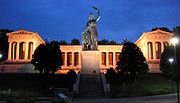
Since 1850, the statue of Bavaria has watched the Oktoberfest. This worldly Bavarian patron was first sketched by Leo von Klenze in a classic style and Ludwig Michael Schwanthaler romanticised and "Germanised" the draft; it was constructed by Johann Baptist Stiglmaier and Ferdinand von Miller.
In 1853, the Bavarian Ruhmeshalle was finished. In 1854, 3,000 residents of Munich succumbed to an epidemic of cholera, so the festival was cancelled. Also, in the year 1866, there was no Oktoberfest as Bavaria fought in the Austro-Prussian War. In 1870, the Franco-Prussian war was the reason for cancellation of the festival. In 1873, the festival was once more cancelled due to a cholera epidemic. In 1880, the electric light illuminated over 400 booths and tents. In 1881, booths selling bratwursts opened. Beer was first served in glass mugs in 1892.
At the end of the 19th century, a re-organization took place. Until then, there were games of skittles, large dance floors, and trees for climbing in the beer booths. They wanted more room for guests and musicians. The booths became beer halls.
In 1887, the Entry of the Oktoberfest Staff and Breweries took place for the first time. This event showcases the splendidly decorated horse teams of the breweries and the bands that play in the festival tents. This event always takes place on the first Saturday of the Oktoberfest and symbolises the official prelude to the Oktoberfest celebration
In the year 1910, Oktoberfest celebrated its 100th birthday. 120,000 litres of beer were poured. In 1913, the Bräurosl was founded, which was the largest Oktoberfest beer tent of all time, with room for about 12,000 guests (today, the biggest tent is the Hofbräu-Festhalle, which holds 10,000).
[edit] War years
From 1914 to 1918, World War I prevented the celebration of Oktoberfest. In 1919 and 1920, the two years after the war, Munich celebrated only an "Autumn Fest." In 1923 and 1924, the Oktoberfest was not held due to inflation.
In 1933, the Bavarian white and blue flag was replaced with the standard swastika flag. From 1939 to 1945, due to World War II, no Oktoberfest took place. From 1946 to 1948, after the war, Munich once again celebrated only the "Autumn Fest." The sale of proper Oktoberfest beer was not permitted; the guests had to make do with beer that had an alcohol content under 2%.
Since its beginnings the Oktoberfest has thus been cancelled 24 times due to war, disease and other emergencies.
[edit] Modern festival
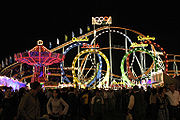
Since 1950, there has been a traditional festival opening: A twelve gun salute and the tapping of the first keg of Oktoberfest beer at 12:00 by the current Mayor of Munich with the cry "O'zapft is!" ("It's tapped!" in the Austro-Bavarian dialect) opens the Oktoberfest. The first mayor to tap the keg was Thomas Wimmer.
By 1960, the Oktoberfest had turned into an enormous world-famous festival. After this foreigners began to picture Germans as wearing the Sennerhut, Lederhosen, and the girls in Dirndl. Horse races ended in 1960.
There are many problems every year with young people, who overestimate their ability to handle large amounts of alcohol. Many pass out due to drunkenness. These especially drunk patrons are often called "Bierleichen" (German for "beer corpses"). They are brought by staff to a medical tent where drunks as well as sick people are treated.
To keep the Oktoberfest, and especially the beer tents, friendly for older people and families, the concept of the "quiet Oktoberfest" was developed in 2005. Until 6:00 PM, the tents only play quiet music, for example traditional wind music. Only after that will Schlager and pop music be played, which has led to more violence in earlier years.[5] The music played in the afternoon is limited to 85 decibels. With these measures, the organizers of the Oktoberfest hope to curb the over-the-top party mentality and preserve the traditional beer tent atmosphere.
Since 2005 the last traveling Enterprise ride of Germany - called Mondlift - is back on the Oktoberfest.
Starting in 2008, a new Bavarian law banning smoking in all enclosed spaces that are open to the public will be in place at the Oktoberfest. This will mean a complete smoking ban inside the tents. However, after heavy losses in the 2008 local elections, the state's ruling party wants to grant special exemptions to beer tents and small pubs.[6] In 2008, the organisers used a special exemption in 2008 for temporary structures so smoking was permitted in the tents although the sale of tobacco was not. This may not work for Oktoberfest in 2009.[7]
[edit] 1980 pipe bomb incident
A pipe bomb was set off in a dustbin at the restrooms at the main entrance on September 26, 1980 at 10:19 PM. The bomb consisted of an empty fire extinguisher filled with 1.39 kilograms of TNT and mortar shells. Thirteen people were killed, over 200 were injured, 68 seriously. This was the deadliest terrorist attack in the history of Germany after the Munich Massacre. The official inquiries found that a right-wing extremist Gundolf Köhler from Donaueschingen, a social outcast who did not get away in time and killed himself in the explosion, was the lone perpetrator. However, this account is disputed strongly by various groups.[8]
[edit] Facts and data
[edit] Size
The Oktoberfest is known as the Largest Volksfest (People's Fair) in the World.[9] In 1999 there were six and a half million visitors[10] to the 42 hectare Theresienwiese. 72% of the people are from Bavaria.[11] 15% of visitors come from foreign countries like the surrounding EU-countries and other non-European countries including the United States, India, Japan, Brazil and Australia.[12]
Besides the Oktoberfest, there are other public festivals that take place at the same location, in April/May: The Munich Frühlingsfest (Spring Festival) and Winter Tollwood in December with 650,000 visitors.
After the Oktoberfest the next people fairs in size in Germany are the Cranger Kirmes in Herne(Wanne-Eickel) (the largest fair in Northrhine-Westphalia) with 4,7 million visitors, the Rheinkirmes in Düsseldorf (called Largest Fair on the Rhine) and the Freimarkt in Bremen (the oldest fair in Germany, held since 1035, and the biggest fair in Northern Germany) with about 4 million visitors per year each, followed by the Cannstatter Volksfest in Stuttgart with about 3 million visitors each year and the "Schützenfest Hannover", the world's largest marksmen's Fun Fair in Hanover with about 2 million visitors per year.
[edit] Dates
| Year | Dates | Special Features |
|---|---|---|
| 2000 | Sep. 16th - Oct. 3rd | 18 Days |
| 2001 | Sep. 22nd - Oct. 7th | |
| 2002 | Sep. 21st - Oct. 6th | |
| 2003 | Sep. 20th - Oct. 5th | |
| 2004 | Sep. 18th - Oct. 3rd | with ZLF* |
| 2005 | Sep. 17th - Oct. 3rd | 17 Days |
| 2006 | Sep. 16th - Oct. 3rd | 18 Days |
| 2007 | Sep. 22nd - Oct. 7th | |
| 2008 | Sep. 20th - Oct. 5th | 175th Oktoberfest (with ZLF*) |
| 2009 | Sep. 19th - Oct. 4th | |
| 2010 | Sep. 18th - Oct. 3rd | 200 Year Anniversary (with BLF!) |
| 2011 | Sep. 17th - Oct. 3rd | 17 Days |
| 2012 | Sep. 22nd - Oct. 7th | |
| 2013 | Sep. 21st - Oct. 6th | |
| 2014 | Sep. 20th - Oct. 5th | |
| 2015 | Sep. 19th - Oct. 4th |
| *Bayerisches Zentral-Landwirtschaftsfest (Bavarian Central Agriculture Festival) |
[edit] Oktoberfest numbers (2007)
- Area: 103.79 acres (0.42 km²)
- Seats in the festival halls: ca. 100,000
- Visitors: 6.2 million
- Beer: appr. 6,940,600 litres (126,900 litres non-alcoholic)
- Wine: 79,624 litres
- Sparkling wine: 32,047 litres
- Coffee, tea: 222,725 litres
- Water, lemonade: 909,765 ½ litres
- Chicken: 521,872 units
- Pork sausages: 142,253 pairs
- Fish: 38,650 kg
- Pork knuckles: 58,446 units
- Oxen: 104 units,
- Expenditure of electricity: 2.8 million kWh (as much as 14% of Munich's daily need or as much as a four person family will need in 52 years and 4 months)
- Expenditure of gas: about 205,000 m³
- Expenditure of water: about 90,000 m³ (as much as 27% of Munich's daily need )
- Waste: 678 t (2004)
- Toilets: about 980 seated, more than 878 metres of urinals and 17 for disabled persons.
- Telephones: 83, also for international credit cards.
- Lost property: about 4000 items, among them 260 pairs of glasses, 200 mobile phones, wedding rings, crutches, and even dentures.[13]
[edit] Refuse and toilets
Nearly 1,000 tons of refuse result annually from the Oktoberfest. The mountains of refuse created are hauled away and the ways cleanly washed down each morning. The cleaning is paid for in part by the city of Munich and in part by the sponsors.
After 2004 the queues for toilets became so long that the police had to regulate the entrance. To keep traffic moving through the restrooms, men headed for the toilets were directed to the "Pissoir" (giant enclosed grate) if they only needed to urinate. The number of toilets was increased in 2005 by 20%. Now approximately 1,800 toilets and urinals are available.
Many Oktoberfest guests visit the quiet stalls in order to use their cell phones. For this reason it was planned in the year 2005 to install a Faraday cage around the toilets and to prevent telephoning with a mobile telephone. However such constructions are not certified in Germany, and so instead signs were placed warning toilet users not to use cell phones in the stalls.
Even with the availability of toilets, it is not uncommon to see many inebriated guests urinating on the small hills and trees surrounding the grounds.
[edit] Tents
There are currently fourteen main tents at the Oktoberfest. The tents themselves are non-permanent structures which are constructed for and only used during the festival. The beer (or wine) served in each is in the accompanying table.
| Name | Brewery | Seating | |
|---|---|---|---|
| inside | outside | ||
| Hippodrom | Spaten-Franziskaner-Bräu | 3,200 | 1,000 |
| Armbrustschützenzelt | Paulaner | 5,839 | 1,600 |
| Hofbräu-Festzelt | Hofbräu München | 6,896 | 3,622 |
| Hacker-Festzelt | Hacker-Pschorr | 6,900 | 2,400 |
| Schottenhamel | Spaten-Franziskaner-Bräu | 6,000 | 4,000 |
| Winzerer Fähndl | Paulaner | 8,450 | 2,450 |
| Schützen-Festhalle | Löwenbräu | 4,442 | 0 |
| Käfers Wiesen Schänke | Paulaner | 1,000 | 1,900 |
| Weinzelt | Nymphenburger Sekt | 1,300 | 600 |
| Paulaner Weißbier | |||
| Löwenbräu-Festhalle | 5,700 | 2,800 | |
| Bräurosl | Hacker-Pschorr | 6,000 | 2,200 |
| Augustiner-Festhalle | Augustiner Bräu | 6,000 | 2,500 |
| Ochsenbraterei | Spaten | 5,900 | 1,500 |
| Fischer Vroni | Augustiner | 2,695 | 700 |
- Hippodrom — One of the smaller tents, it's the first tent that many visitors see at the fest. As well as serving normal Wiesn beer, it has a Sekt (sparkling wine) bar and Maß of Weißbier. Considered one of the trendiest tents, and attracts the occasional celebrity. Traditionally in the evening the Oktoberfest band the Münchner Zwietracht plays all the Oktoberfestclassics.
- Armbrustschützenzelt — Translates as the "Crossbow Shooters Tent", a competition that has been a part of the Oktoberfest since 1895.
- Hofbräu-Festzelt — The counterpart to the famous Hofbräuhaus, this tent is especially popular with Americans, Australians and New Zealanders.
- Hacker-Festzelt — One of the largest tents on the Wiesn, they have a rock band that plays from 5:30 each evening (as opposed to the traditional brass band). This tent is also known as "Himmel der Bayern" (Heaven of Bavaria)
- Schottenhamel — Reckoned to be the most important tent at the Oktoberfest, mainly because it is where it starts. On the first Saturday of the event, no beer is allowed to be served until the mayor of Munich (currently Christian Ude) taps the first keg, at 12pm. Only then can the other tents begin to serve beer. Very popular amongst younger people.
- Winzerer Fähndl — This tent is noted for its huge tower, with a Maß of Paulaner beer sitting atop it.
- Schützen-Festhalle — This is a mid-sized tent. Situated under the Bavaria statue, the current tent was newly built in 2004.
- Käfers Wiesen Schänke — The smallest tent at the Oktoberfest, it is frequented by celebrities, and is known for its especially good food. In contrast to the other tents (which must close by 11pm), it is open until 0:30am, but it can be very difficult to get in.
- Weinzelt — This tent offers a selection of more than 15 wines, as well as Weißbier.
- Löwenbräu-Festhalle — Above the entrance is a 4.50 meter (15 foot) lion who occasionally drinks from his beer. This is overshadowed by another tower where another drinking lion sits.
- Bräurosl (Hacker-Pschorr) — Named after the daughter of the original brewery owner (Pschorr), this tent has the usual brass band and a yodeler.
- Augustiner-Festhalle — Considered by many locals to be the best tent, due to the fact it sells the favourite local brew, Augustiner, from individually tapped wooden kegs rather than stainless steel vats used by the other tents.
- Ochsenbraterei — True to its name, this tent offers a great variety of ox dishes.
- Fischer Vroni — Another of the smaller tents. Fisch is the German word for fish and this tent carries a huge selection in its menu.
[edit] Price of a Maß

One of the biggest talking points among citizens of Munich in the lead-up to the Oktoberfest each year is how much a litre of beer will cost.
Officially stated price ranges:
- 2005: €6.65 - €7.10
- 2006: €6.95 - €7.50
- 2007: €7.30 - €7.90
- 2008: €8.00 - €8.30
[edit] Souvenir mugs
Oktoberfest beer mugs (1-litre-Steins, Maßkrug in German) are made from heavy glass and typically have a decorative brewery logo on the side, thus making them very popular souvenirs among visitors. Although it is strictly forbidden to steal the mugs, they can be purchased in the tents at a reasonable price. Buyers are strongly advised to keep the receipts because police are known to search them for stolen mugs even away from the fest area. When police catch someone stealing a mug, the thieves may be fined up to €50. In addition there is a general Oktoberfest souvenir mug which shows each year's Oktoberfest poster. This one is made of clay instead of glass and is available with a pewter lid.
Oktoberfest regulars will often return with steins from previous years, demonstrating their dedication to Oktoberfest and the traditional stein.
[edit] Cultural references
| Lists of miscellaneous information should be avoided. Please relocate any relevant information into appropriate sections or articles. (September 2008) |
- Inspector Clouseau visits Oktoberfest in the 1976 movie The Pink Panther Strikes Again.
- Oktoberfest is featured prominently in the 2006 movie Beerfest.
- The medic character in the game Team Fortress 2 shouts "Oktoberfest!" as a battle cry.
- In Supernatural, Dean and Sam attend Oktoberfest in the episode 'Monster Movie'.
- In One Tree Hill, one of the things that Brooke has always wanted to do is to attend Oktoberfest.
[edit] See also
| Wikimedia Commons has media related to: Oktoberfest |
- German beer
- Beer festival
- Carnival
- Stuttgart Spring and Autumn Festival
- Volksfest
- Kitchener-Waterloo Oktoberfest
- Tatamagouche
- Oktoberfest celebrations
- Queima das Fitas
- Heinerfest
- Beer Day (Iceland)
[edit] References
- ^ "Big Six Breweries in Munich". www.beerdrinkersguide.com. http://www.beerdrinkersguide.com/BDGWebsite/MunichBeer/BigSix.htm. Retrieved on 2008-05-04.
- ^ "Food from Bavaria - Regionaltypische Spezialität". www.food-from-bavaria.de. http://www.food-from-bavaria.de/de/reg_spez/einzelprodukt.php?an=113&display_lang=en. Retrieved on 2008-05-04.
- ^ "Michael Jackson's Beer Hunter - The birth of lager". www.beerhunter.com. http://www.beerhunter.com/documents/19133-000255.html. Retrieved on 2008-05-04.
- ^ "BJCP 2008 Style Guidelines - Category 03". www.bjcp.org. http://www.bjcp.org/2008styles/style03.html#1b. Retrieved on 2008-05-04.
- ^ "Rules for Oktoberfest jeered". www.houblon.net. http://www.houblon.net/spip.php?article2482. Retrieved on 2008-09-20.
- ^ The change in regulation is aimed in particular at large tents at the Oktoberfest: Up in Smoke: Bavarian Politicians Want to Relax Smoking Ban.
- ^ regarding smoking at the Oktoberfest
- ^ Daniele Ganser: Nato-Geheimarmeen und ihr Terror (German)
- ^ "How to enjoy Oktoberfest like a local - USATODAY.com". http://www.usatoday.com/travel/destinations/2007-09-05-oktoberfest-local-tips_N.htm.
- ^ "Realbeer.com: Beer News: Oktoberfest visitors set records". http://www.realbeer.com/news/articles/news-000283.php.
- ^ muenchen.de - Informationen zum Oktoberfest (German)
- ^ "muenchen.de - Press Release Oktoberfest Economics". http://www.muenchen.de/Rathaus/tourist_office/presse/Press_Releases/142504/octoberfest_economic_factor_2005.html.
- ^ "muenchen.de - Statistics". http://www.muenchen.de/Rathaus/tourist_office/oktobfest/126031/oktoberfest_Zahlen_Statistiken.html.
[edit] External links
- Munich Oktoberfest Official Munich Oktoberfest website
- Official Oktoberfest website (German);
- for English-speaking visitors (English)
- Oktoberfest Club - Fan Site; Oktoberfest information, Online Store, Chatroom and forum
- Italian Website about Oktoberfest
- Big D's Hilarious Travel Video of Octoberfest in Munich
- Munich Oktoberfest latest Oktoberfest News (German)
- German Food Guide - Find Oktoberfest Celebrations in the USA
- Oktoberfest — Information Portal
- Hippodrom
- Hofbräu Oktoberfest Beertent
- Hacker-Festzelt
- Schottenhamel
- Ochsenbraterei
- Fischer Vroni
- Oktoberfest Shop - Official Munich Oktoberfest Souvenirs and Steins
- US Oktoberfest Shop - Official Oktoberfest Souvenirs and Party decorations
- Beer Gear - Official Munich Oktoberfest Steins
- Webcamplaza.net
- Festival of Beer: The Where and When of Beer Festivals
